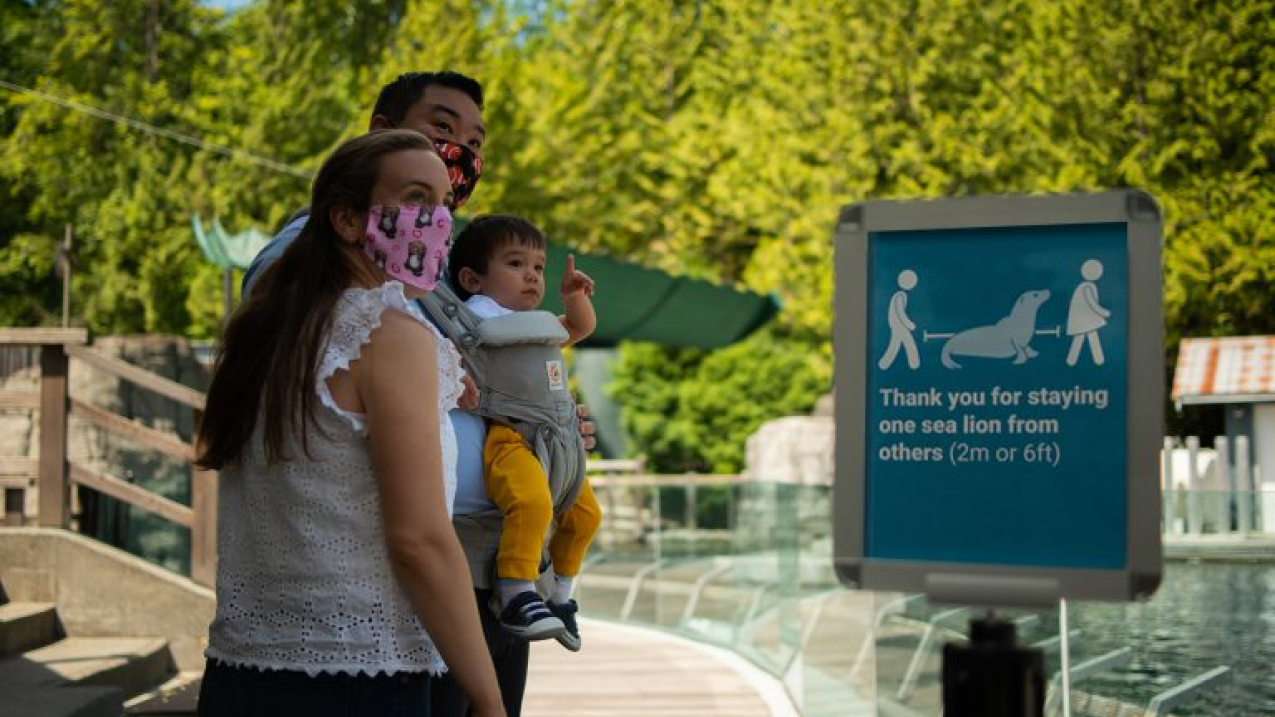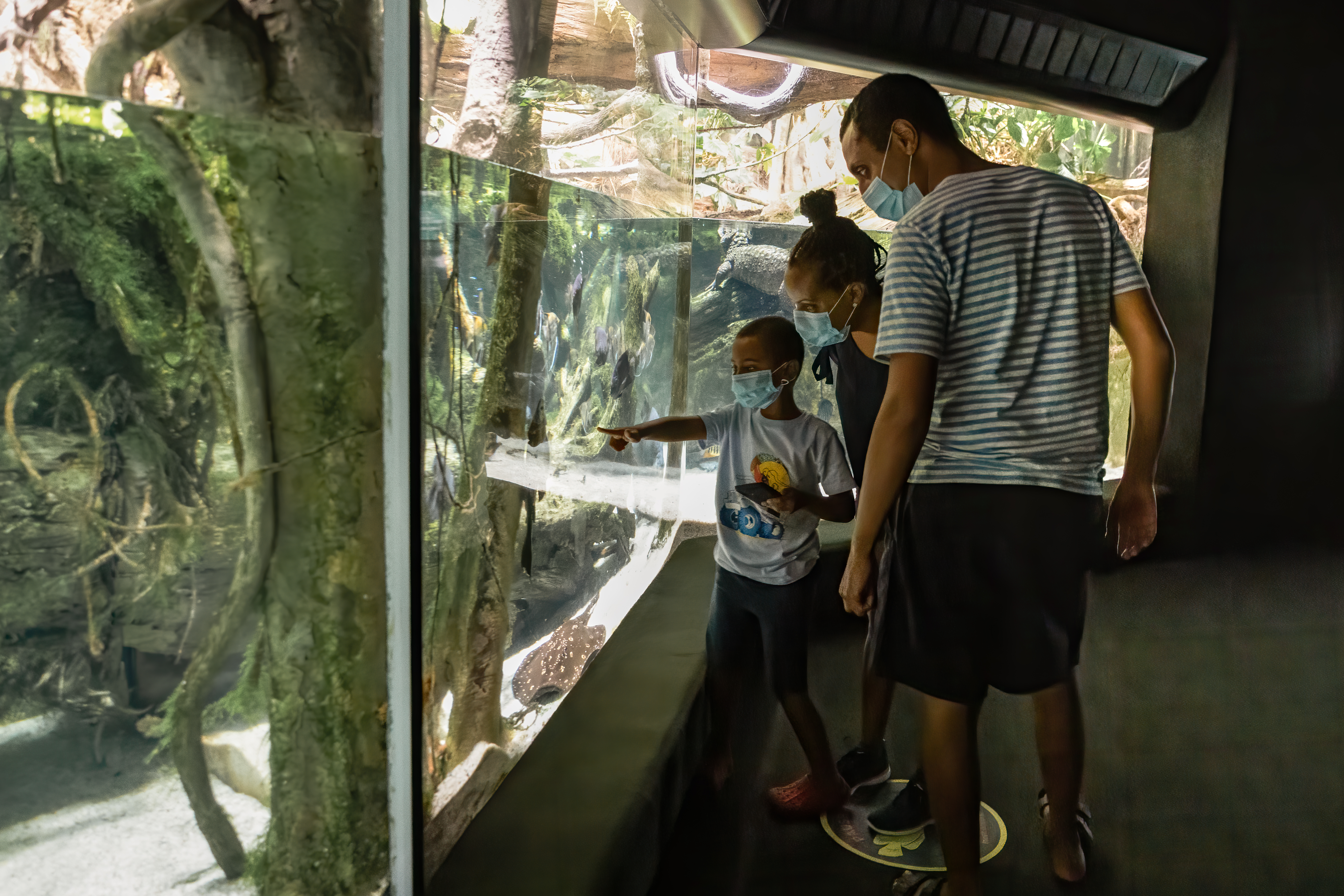In the early days of the COVID-19 pandemic, a video of Shedd Aquarium penguins waddling through a beluga whale exhibit spread across the internet — a welcome reprieve from the barrage of bad news. Like many businesses, aquariums across the continent temporarily shut their doors to visitors in the spring of 2020 as the pandemic started to take hold.
While these closures allowed for fun penguin field trips to watch from the safety of our homes, aquarium employees were putting in serious work behind the scenes to revamp everything from visitor flow through their buildings to summer camp programming.
Their challenge: continue to meet the aquariums' education and conservation missions while keeping visitors safe.

A masked family at an aquarium looks at something off-camera, standing in back of a sign that reads, “Thank you for staying one sea lion from others (2 m or 6 ft).” (Image credit: Vancouver Aquarium)
That's where NOAA's Coastal Ecosystem Learning Centers (CELC) network sprung into action. Coordinated by NOAA’s Office of Education, this consortium of 25 aquariums and marine science centers across North America works together to engage the public in protecting coastal and marine ecosystems. Education directors from these aquariums generally meet virtually once a month to work toward shared priorities and hear about new ways to connect with NOAA. But when aquariums began to feel the impacts of the pandemic, the network chose to meet twice as often to work through pandemic responses.
"Our roles in our facilities changed so drastically, so quickly,” said Windy Arey-Kent, education curator for North Carolina Aquarium at Pine Knoll Shores offsite link. “CELC facilitated important conversations between education professionals within CELC to help us better support our teams and our facilities.”
Please stay six penguins apart!
During meetings facilitated by NOAA, network members grappled with pressing questions of how to provide high quality virtual learning experiences, how to prepare for a safe return to in-person activities, and how to support the mental health of aquarium staff during these stressful times.
“CELC helped our River Museum team with specific steps for reopening touch tanks and other interactive animal areas,” said Jonathan Ismail, education manager at the National Mississippi River Museum & Aquarium offsite link. “Other aquariums provided diagrams, protocol, and advice that helped shape our reopening practices for COVID safety.” The group even brainstormed signage that could help guests visualize what six feet of physical distancing looked like: stay one alligator gar, two rays, or six penguins apart!

Moving education online
Even with their doors temporarily closed, CELC institutions were able to bring in guests from around the world to experience the aquariums virtually and learn about their inhabitants through innovative online learning experiences. NOAA’s Office of Education curated a list of these virtual events, allowing people near and far from the aquariums to explore new educational offerings. The pandemic also didn’t stop the network from continuing to push forward on other group priorities, including professional development and youth engagement.
To help aquarium staff become more confident with teaching guests about sustainable aquaculture, for example, many network members attended NOAA’s virtual aquaculture education professional development workshop in collaboration with NOAA scientists and educators. This workshop helped lay the foundation for a new mini-grant opportunity focused on building aquaculture literacy through collaborations between aquariums, industry, and NOAA scientists. (Mini-grant applications are due on April 2, 2021.)
Additionally, several aquariums in the group brought together youth teams to participate in Monterey Bay Aquarium’s three-day online advocacy forum offsite link, which was organized by young people and for young people.
“CELC provided a network of youth … to reach out to when our summer interns developed summer online advocacy forums,” explained Kim Swan, manager of teen programs at Monterey Bay Aquarium offsite link. “We ended up with representatives from 15 different programs, primarily from this network!”
Engagement in these efforts demonstrates the group’s dedication to educating the public and themselves, even during times of crisis.
‘Hope in the storm’
Perhaps just as importantly, the collaborations that NOAA facilitated through CELC gave aquarium staff members an extra dose of hope and perseverance during a trying time.
“CELC was a great support for me and my staff during the worst of the COVID shut-down crisis. We were able to maintain our meetings and conversations despite all that was happening with budget and staff cuts all over the industry, sharing experiences, ideas, sympathetic ears, and shoulders when needed,” said Jeff Dillon, senior education manager for the Alaska SeaLife Center offsite link. “Knowing my CELC partners were in it with us was a buoy of hope in the storm.”
While the risks of the pandemic kept people apart physically, it brought the CELC network closer together as aquariums worked collaboratively to stay safe, educational, and afloat. “The CELC network is an extension of our NOAA education family,” said Christos Michalopoulos, deputy director of NOAA’s Office of Education. “We are grateful to be emerging from last year’s challenges, and we are looking forward to working together through the storms and the sunshine in the years to come.”



